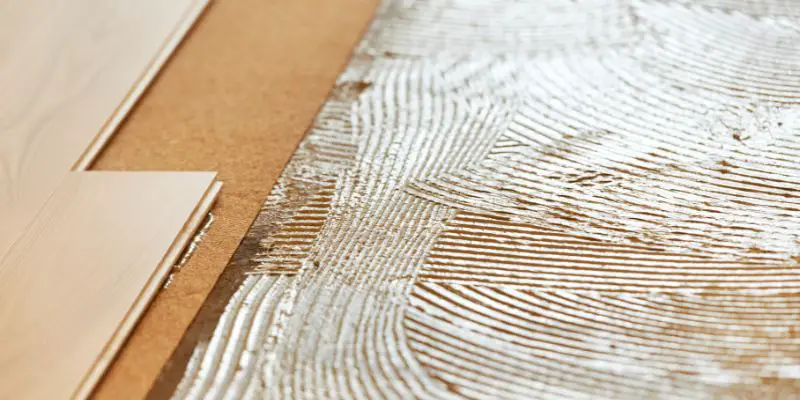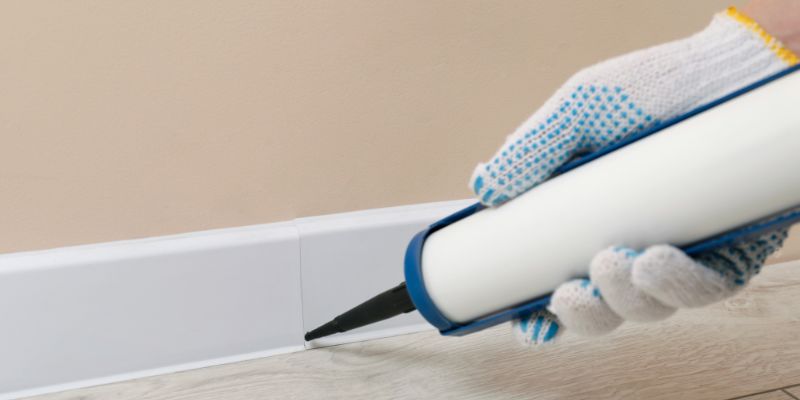The best glue to use for laminate flooring is a premium quality PVA adhesive or a laminate-specific adhesive. Using the right glue is crucial for ensuring a secure and long-lasting bond between the laminate planks and the subfloor.
When installing laminate flooring, choosing the right glue is essential. The adhesive must be strong and reliable to prevent any movement or separation of the planks over time. Two popular options for laminate flooring are premium quality PVA adhesive and laminate-specific adhesive.
Both types of glue provide a secure bond between the laminate planks and the subfloor, ensuring durability and stability. By using the appropriate glue, you can achieve a professional and seamless installation of your laminate flooring.
Knowledge Laminate Flooring
Laminate flooring is a popular choice for many homeowners due to its durability, versatility, and affordability. Whether you are renovating your entire home or just a small space, laminate flooring offers an attractive and practical solution. In this article, we will explore what laminate flooring is, its benefits, and common issues that you may encounter.
What Is Laminate Flooring?
Laminate flooring is a synthetic flooring product that imitates the look of hardwood, stone, or tile. It is composed of multiple layers that are fused together through a lamination process. The top layer, also known as the wear layer, provides protection against scratches, stains, and UV rays. Beneath the wear layer, there is a printed design layer that replicates the appearance of natural materials. The core layer, usually made of high-density fiberboard (HDF) or medium-density fiberboard (MDF), gives laminate flooring its stability and strength. Finally, the bottom layer, known as the balancing layer, provides moisture resistance and stability.

Benefits Of Laminate Flooring
Laminate flooring offers several advantages that make it a popular choice among homeowners:
- Durability: Laminate flooring is highly durable and can withstand heavy foot traffic, making it perfect for busy areas of the home.
- Easy Maintenance: Unlike hardwood flooring, laminate floors are easy to clean. Regular sweeping and occasional mopping are usually sufficient to keep them looking their best.
- Variety of Designs: Laminate flooring is available in a wide range of designs, including various wood, stone, and tile looks. This allows you to find the perfect style to complement your home’s decor.
- Cost-Effective: Laminate flooring is more affordable compared to hardwood or natural stone flooring options, making it suitable for budget-conscious homeowners.
- Installation: Laminate flooring is designed with a click-and-lock system, making it a popular choice for DIY enthusiasts. It can be installed quickly and easily without the need for glue or nails.
Common Issues With Laminate Flooring
While laminate flooring offers many benefits, there are a few common issues that homeowners may encounter:
- Moisture Damage: Laminate flooring is susceptible to moisture damage, particularly when exposed to excessive water or humidity. It is essential to clean up spills promptly and avoid installing laminate in areas prone to moisture, such as bathrooms and basements.
- Scratches and Dents: While laminate flooring is durable, it can still be susceptible to scratches and dents from sharp objects or heavy furniture. Placing felt pads under furniture legs and using protective mats can help prevent damage.
- Peaking or Buckling: Changes in temperature and humidity levels can cause laminate flooring to expand and contract, leading to peaking or buckling. Proper acclimation and installation techniques can help mitigate this issue.
- Subfloor Imperfections: Uneven or damaged subfloors can impact the overall performance and appearance of laminate flooring. It is crucial to prepare the subfloor properly before installation.
By understanding what laminate flooring is, its benefits, and common issues, you can make an informed decision about whether it is the right choice for your home. With proper care and maintenance, laminate flooring can provide you with a durable and stylish flooring solution that will last for many years to come.
Importance Of Using Glue For Laminate Flooring
Using the right glue for laminate flooring is essential for its longevity and stability. The proper adhesive ensures a secure bond between the laminate and the subfloor, preventing any movement or lifting over time. This ensures that your laminate flooring remains durable and is able to withstand daily wear and tear.
Why Use Glue For Laminate Flooring?
Using glue for laminate flooring is essential for ensuring a safe and durable installation. While some people may opt for floating floor installations without glue, it is important to understand the reasons why using glue is highly recommended.
Types Of Laminate Flooring That Require Glue
Not all types of laminate flooring require glue for installation. However, there are certain types of laminate flooring where using glue is necessary to achieve proper adhesion and stability. These include:
- 1. Glue-down laminate flooring: This type of laminate flooring is specifically designed to be installed using glue. It provides excellent stability and resistance to moisture, making it a suitable choice for kitchens, bathrooms, and other high-moisture areas.
- 2. Laminate flooring with underlayment attached: Some laminate flooring comes with underlayment already attached to the planks. In such cases, using glue is necessary to ensure a secure bond between the planks and the subfloor.
Advantages Of Using Glue For Laminate Flooring
There are several advantages to using glue for laminate flooring, making it a popular choice among homeowners. These advantages include:
- Enhanced durability: Glued-down laminate flooring tends to be more resistant to wear and tear compared to floating installations. The glue creates a strong bond, preventing the planks from shifting or separating over time.
- Improved stability: Glue helps to stabilize the laminate flooring, reducing the risk of squeaking and movement. This is particularly beneficial in high-traffic areas or when heavy objects are placed on the floor.
- Moisture protection: Glue-down laminate flooring with moisture-resistant properties provides an extra layer of protection against water damage. This is important in areas prone to spills or high humidity levels.
- Reduced noise: The use of glue in laminate flooring installations helps to minimize sound transmission, creating a quieter environment within the room.
- Professional finish: Glue ensures a seamless and professional-looking installation, with no visible gaps or unevenness between the individual planks.
Choosing The Right Glue For Laminate Flooring
When it comes to installing laminate flooring, using the right glue is crucial for long-lasting results. The glue not only helps to secure the planks but also provides stability and prevents any movement or shifting over time. With various types of glues available in the market, it can be overwhelming to choose the right one for your specific laminate flooring project. In this article, we will look at the factors to consider, the different types of glue, and some recommended brands to help you make an informed decision.
Factors To Consider
When selecting a glue for laminate flooring, there are a few key factors to consider:
- The type of subfloor: Different subfloors require different types of glue. Whether you have a concrete, wood, or vinyl subfloor, it is important to choose a glue that is compatible with the material.
- Maintenance needs: Some glues may require specific maintenance or cleaning methods. Consider your ability to maintain the flooring and choose a glue that aligns with your requirements.
- Drying time: If you are working on a tight schedule or have limited time, opt for a glue that dries quickly to minimize installation time.
- Environmental concerns: If you are conscious about using eco-friendly products, look for glues that are low in VOC (volatile organic compounds) and are environmentally friendly.
Types Of Glue For Laminate Flooring
Several types of glues are commonly used for laminate flooring installation:
| Type of Glue | Description |
|---|---|
| PVA (Polyvinyl Acetate) Glue | A popular and affordable option, PVA glue is water-based and provides a strong bond for laminate flooring. It is easy to work with and dries clear. |
| Epoxy Glue | Epoxy adhesive is known for its exceptional strength and durability. It is suitable for high-traffic areas and offers excellent resistance against moisture and chemicals. |
| Urethane-Based Glue | This type of glue provides superior bonding strength and is resistant to moisture. It is ideal for areas prone to spills or humidity. |
| Modified Silane Polymer Glue | Known for its flexibility and elasticity, modified silane polymer glue offers a strong bond and is suitable for laminate flooring installations in areas with slight subfloor movements. |
Recommended Glue Brands
When it comes to choosing the right glue for your laminate flooring, it is advisable to opt for reputable brands known for their quality and reliability. Here are some recommended glue brands:
- DAP
- Roberts
- Bostik
- Titebond
- FloorMuffler
These brands have been well-regarded in the flooring industry, offering a range of glues specifically designed for laminate flooring installations. It is always a good idea to read product reviews and consult with professionals to ensure you select the most suitable glue for your project.

Step-by-step Guide To Using Glue For Laminate Flooring
Discover the perfect adhesive for your laminate flooring installation with this easy-to-follow step-by-step guide. Learn which glue works best for laminate flooring to ensure a durable and long-lasting result.
Laminate flooring is a popular and cost-effective choice for homeowners looking to upgrade their floors. While many laminate floors come with a click-lock installation system, using glue can provide added stability and durability. In this step-by-step guide, we will walk you through the process of using glue for your laminate flooring installation, ensuring a successful and long-lasting result.
Preparation
Before you start applying glue, it’s important to properly prepare the surface to ensure a strong bond. Follow these steps:
- Ensure that the subfloor is clean, flat, and free of any debris or dust. Use a broom or vacuum cleaner to remove any loose particles.
- If there are any imperfections or uneven areas on the subfloor, use a floor leveling compound to create a smooth surface.
- Measure the dimensions of the room and calculate the amount of glue you will need. It’s always better to have a little extra to avoid running out mid-installation.
Applying The Glue
Now that the preparation is done, it’s time to apply the glue. Follow these steps:
- Start by applying a thin, even layer of glue on the subfloor using a trowel or a recommended glue applicator tool. Be sure to follow the manufacturer’s instructions for the specific type of glue you are using.
- Work in small sections to prevent the glue from drying before you can lay the laminate flooring. Keep a damp cloth nearby to wipe off any excess glue that may seep through the joints.
- Place the first laminate plank at the starting point, ensuring it is aligned properly. Press it down firmly to create a strong bond with the glue.
- Repeat the process for the remaining planks, making sure to leave a small gap between each one for expansion.
Installing The Laminate Flooring
With the glue applied, it’s time to install the laminate flooring. Follow these steps:
- Begin by placing the first row of planks along the starting wall, using spacers to maintain a consistent gap between the planks and the wall.
- Continue installing subsequent rows, interlocking the planks by angling them and gently pressing them together. Use a tapping block and a mallet to ensure a tight fit.
- Periodically check for levelness and adjust as needed.
- Once all the planks are installed, remove the spacers and use a roller or a heavy object to firmly press down the entire floor, ensuring proper adhesion.
Drying And Curing Time
After the installation, it’s crucial to allow sufficient drying and curing time for the glue to set. This time may vary depending on the specific type of glue used, as well as environmental conditions such as temperature and humidity. Refer to the manufacturer’s instructions for the recommended drying and curing time.
In conclusion, using glue for laminate flooring can provide additional stability and durability. By following this step-by-step guide, you can ensure a successful installation that will stand the test of time.
Tips And Tricks For Using Glue With Laminate Flooring
Find out the best glue to use for laminate flooring with these tips and tricks. Discover how to ensure a strong and secure bond that will last for years. Implementing the right adhesive can make a significant difference in the durability and stability of your laminate flooring installation.
Working With Difficult Surfaces
When it comes to installing laminate flooring, there may be some surfaces that pose a challenge. Working with difficult surfaces requires extra care and attention to ensure the glue bonds effectively. Here are some tips and tricks for working with difficult surfaces:
- Prepare the surface properly before applying the glue. Make sure it is clean, dry, and free from dust, debris, and any other contaminants.
- If the surface is uneven or has cracks, consider using a self-leveling compound to create a smooth and even base for the laminate flooring.
- If the surface is smooth and non-absorbent, such as tiles or vinyl, roughen it up using sandpaper or a sanding machine. This will help the glue adhere better.
- If the surface is porous, apply a primer or a sealant to seal the pores. This will prevent the glue from being absorbed too quickly and ensure a strong bond.
- When applying the glue, be generous but not excessive. Follow the manufacturer’s instructions to determine the appropriate amount of glue to use.
Fixing Common Glue-related Problems
Sometimes, despite our best efforts, problems may arise when using glue with laminate flooring. Here are some common problems and their solutions:
- If the glue starts to dry before you can lay down the laminate flooring, stop and remove the dried glue using a scraper. Then, reapply fresh glue before continuing.
- If you notice gaps or separations between the laminate planks after installation, it could be due to insufficient glue. Carefully lift the affected area, apply more glue, and press the planks firmly together.
- In rare cases, the glue may seep up onto the laminate surface, leaving behind unsightly residue. To remove the residue, gently scrape it off using a plastic scraper or a credit card. Wipe the area with a clean cloth or a mild cleaner to remove any remaining residue.
- If the glue gets onto your skin, don’t panic. Simply wash it off with soap and water. Avoid using solvents or harsh chemicals.
Maintaining And Cleaning Laminate Flooring
Proper maintenance and regular cleaning are essential to keep your laminate flooring in excellent condition. Here are some tips for maintaining and cleaning laminate flooring:
- Always follow the manufacturer’s recommendations for cleaning solutions and methods.
- Sweep or vacuum the floor regularly to remove dirt and debris that can scratch the laminate surface.
- Use a damp mop and a mild, pH-neutral cleaner specifically designed for laminate flooring to clean the surface. Avoid excessive water, as it can seep into the seams and cause damage.
- Wipe up spills immediately using a soft cloth or paper towel to prevent any moisture from seeping into the laminate.
- Avoid using harsh cleaning products, abrasive scrubbers, or wax on laminate flooring, as they can damage the surface.
- Place doormats at entryways to collect dirt and moisture before it reach the laminate flooring.
Conclusion
To sum up, the choice of glue for laminate flooring is crucial in ensuring its durability and stability. By understanding the different types of glues available and their specific applications, you can make an informed decision. Whether you opt for PVA glue, epoxy resin, or a specific laminate adhesive, consider factors such as moisture resistance, ease of application, and manufacturer recommendations.
Remember to follow the instructions carefully to achieve the best results and enjoy a long-lasting laminate floor.


